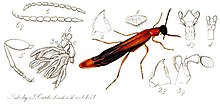Lymexylidae
| Ship-timber beetles Temporal range:
| |
|---|---|

| |
| Lymexylon navale | |
| Scientific classification | |
| Domain: | Eukaryota |
| Kingdom: | Animalia |
| Phylum: | Arthropoda |
| Class: | Insecta |
| Order: | Coleoptera |
| Suborder: | Polyphaga |
| Infraorder: | Cucujiformia |
| Superfamily: | Lymexyloidea |
| Family: | Lymexylidae Fleming, 1821 |

The Lymexylidae (historically often spelled Lymexylonidae), also known as ship-timber beetles, are a family of wood-boring beetles. Lymexylidae belong to the suborder Polyphaga and are the sole member of the superfamily Lymexyloidea.
Habitat and behavior
[edit]
Lymexylon, Elateroides, and Melittomma are pests to forest trees such as chestnut, poplar, and oak, and can be found worldwide. Some species are parasitic, causing decay in living trees and damaging timber structures such as houses and ships. Wood boring activities occur primarily in the larva stage, with the larvae damaging both sapwood and heartwood. Lymexylidae larvae bore into living and decaying wood where they consume the fungus Alloascoidea hylecoeti.[1][2]
Symbiotic relationship with fungi
[edit]Lymexylidae larvae have a symbiotic association with certain types of fungi. The fungi grow in sheltered environments where they are tended by the larvae, such as the holes burrowed into the wood and, in return, the larvae feed on the fungi.[3]
Specifically, this species has evolved a relationship with the yeast-like fungus Endomyces hylecoeti. Every egg the female lays is coated with fungal spores from a pouch near her ovipositor. The larvae hatch and subsequently collect some of the spores by remaining close to the egg shells for a period of time, before tunneling further into the wood. The fungi grow on the tunnel walls created by the larvae. The larvae then consume the fungus, rather than the wood itself. As the fungi require air flow to grow, the larvae ensure the tunnels are free of any debris.[4]
Species and genera
[edit]Lymexylidae contain the following genera:[5]
- Atractocerus Palisot de Beauvois, 1801
- Australymexylon Wheeler, 1986
- Elateroides Schaeffer, 1766
- Lymexylon Fabricius, 1775
- Melittomma Murray, 1867
- Melittommopsis Lane, 1955
- Protomelittomma Wheeler, 1986
- Urtea Paulus, 2004
- †Adamas Chen & Zhang, 2020 Burmese amber, Myanmar, Late Cretaceous (Cenomanian)
- †Cratoatractocerus Wolf-Schwenninger 2011 Crato Formation, Brazil, Early Cretaceous (Aptian)
- †Cretoquadratus Chen 2019 Burmese amber, Myanmar, Cenomanian
- †Ponomarenkylon Kirejtshuk 2008 Baltic amber, Eocene
- †Vetatractocerus Yamamoto 2019 Burmese amber, Myanmar, Cenomanian
There are over 60 species in these genera, including:
- The ship timber beetle, Lymexylon navale
- Two species are located in Eastern US and Canada: the sapwood timberworm Elateroides lugubris (Say) and the chestnut timberworm, Melittomma sericeum
Morphology
[edit]Adult morphology:
- 5–40 mm (0.20–1.6 in) long; elongate to slender, parallel-sided, vestiture consisting of fine setae; conspicuously necked to not necked; somewhat waisted.
- Head short, typically narrowed behind large protruding eyes forming a slight neck; surface punctate, with or without epicranial pit.
- Antennae short 11-segmented, filiform/serrate and often sexually dimorphic.
- Maxillary palpi 4-segmented, simple in most females, and with apical segment modified into a complex flabellate or plumose organ in males-palporgan.
- Tarsi 5-5-5 with legs slender, moderately long.
- Hind-leg coxae extending laterally to meet the elytra (Lymexylon), or not markedly extended laterally (Elateroides).
- Elytra individually tapered to their apices to not individually tapered; fairly short, exposing several terminal abdominal 1-3 tergites; all articulated and moveable.
- Wings with fairly complete venation, radial cell short or absent.
Immature Morphology:
- Whitish-yellow, elongate, thin, cylindrical with short but well developed legs.
- Prognathous, stemmata absent or present may have eye spots.
- Abdominal modifications found in older larvae.
Classification
[edit]The superfamily Lymexyloidea is currently within series Cucujiformia. The internal phylogeny has not been clearly understood/completed by experts. Morphological data places the family inside the Tenebrionoidea, while molecular data place it as sister taxon to Tenebrionoidea, and polyphyletic.
See also
[edit]Notes
[edit]- ^ Cletus P. Kurtzman, Christie J. Robnett (2013) Alloascoidea hylecoeti gen. nov., comb. nov., Alloascoidea africana comb. nov., Ascoidea tarda sp. nov., and Nadsonia starkeyi-henricii comb. nov., new members of the Saccharomycotina (Ascomycota). FEMS Yeast Research 13: 423–432. doi: 10.1111/1567-1364.12044
- ^ Caroline S. Chaboo (2015), "Beetles (Coleoptera) of Peru: A Survey of the Families. Lymexylidae Fleming, 1821", Journal of the Kansas Entomological Society, 88 (2): 258–259, doi:10.2317/kent-88-02-258-259.1
- ^ Casari, Sônia A.; Teixeira, Édson Possidônio (2011). "Larva of Atractocerus brasiliensis (Lepeletier & Audinet-Serville, 1825) (Lymexylidae, Atractocerinae)". Papéis Avulsos de Zoologia. 51 (12): 197–205. doi:10.1590/S0031-10492011001200001. ISSN 0031-1049.
- ^ Ross Piper (2007). Extraordinary Animals: An Encyclopedia of Curious and Unusual Animals. Greenwood Press.
- ^ Lymexylidae Species List at Joel Hallan's Biology Catalog. Texas A&M University. Retrieved on 17 May 2012.
References
[edit]- Arnett, Ross H., et al., eds. American Beetles: Polyphaga: Scarabaeoidea through Curculionoidea. Vol. 2. CRC Press, 2002: 261–262. EBSCO printed on Sept. 21,2013.
- Casari, S.A. and Albertoni, F.F., (2013). First Instar Larva of Atractocerus brasiliensis (Lepeletier & Audinet-Serville, 1825) (Lymexylidae, Atractocerinae). Volume 53(27): 359‑372.
- Kundrata, R., Bocakova, M., & Bocak, L. (2014). The comprehensive phylogeny of the superfamily Elateroidea (Coleoptera: Elateriformia). Molecular Phylogenetics and Evolution, 76, 162–171.
- Triplehorn, Charles A., Norman F. Johnson, and Donald J. Borror. Borror and DeLong's Introduction to the Study of Insects. Belmont, CA: Thompson Brooks/Cole, 2005.
- Wheeler, Q. D. (1986). Revision of the genera of Lymexylidae (Coleoptera: Cucujiformia). Bulletin of the American Museum of Natural History, 183:113-210.
External links
[edit]- L. Watson and M. J. Dallwitz, Lymexylidae
- Lymexylidae on ITIS
- A video of Atractocerus brasiliensis, a ship timber beetle in Costa Rica
